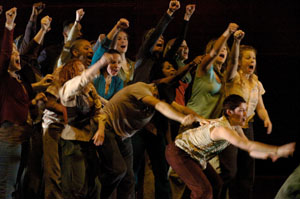6.) DANCE LITERACY Witnessing Dance

Early modern dance taught audiences to look differently, and much contemporary dance extends that curiosity, asking the audience to stay committed to watching even when the subjects become uncomfortable. To witness something implies a responsiveness, the response/ability of the viewer toward the performer. It is radically different from what we might call the "consuming" gaze which says "here, you entertain me, I bought a ticket, and I'm going to sit back and watch." This traditional gaze doesn't want to get involved, doesn't want to give anything back. In contrast, witnessing is much more interactive, a kind of perceiving (with one's whole body) that is committed to a process of mutual dialogue. There are precedents for this responsive watching in Quaker meetings, African American notions of bearing witness, the responsive dynamic of many evangelistic religions, as well as the aesthetic theory of "rasa" in Classical Indian Dance, to mention only a few such examples. This act of "witnessing," however, raises the stakes of audience engagement, sometimes making the audience member uncomfortable, sometimes provoking highly charged responses to the work. This is particularly true of dances that foreground issues of social, political, and cultural experiences or issues. Many contemporary dances bring the audience into the performers experience by capturing not only the action of the movement (the finishing gesture), but also its initiation, the reason why the performers are moving in the first place.
Classroom Activity: Performance Dynamics
Ask the students to make a very elemental sequence of movements using motions that alternately extend out into space and then gather in towards the body. (This can be a simple as opening and closing the arms in conjunction with a slight lift and release in the upper body.) Now have them perform this sequence facing an audience with an emphasis on a big inhalation initiating the movement of expansion. Then have them perform it again with an emphasis on the finishing gesture. Note how this simple shifting of emphasis from the TA-da to the ta-DA creates a very different aesthetic “look,” and have the class discuss the difference in viewing priorities by asking the students what they most pay attention to in each variation.

